For me, a trip to an Umbrian market is not complete without a stop by a
porchettai, a vendor in a white van hawking delicious porchetta sandwiches, a large sandwich of savory roasted pork on a fresh white bun. A tasty snack to revive weary cyclists as we tour Umbria, you can find porchetta sandwiches throughout Italy. My boys and I enjoyed a porchetta sandwich at a music festival in Bolzano. In Umbria, however, one of the hog raising centers of Italy, and renowned for it’s wide array of cured meats, the preparation of porchetta is a serious matter, earning it the Traditional Speciality Guaranteed (TSG) status, which “refers to a foodstuff produced either using traditional raw materials or characterized by a traditional composition or a mode of production.”
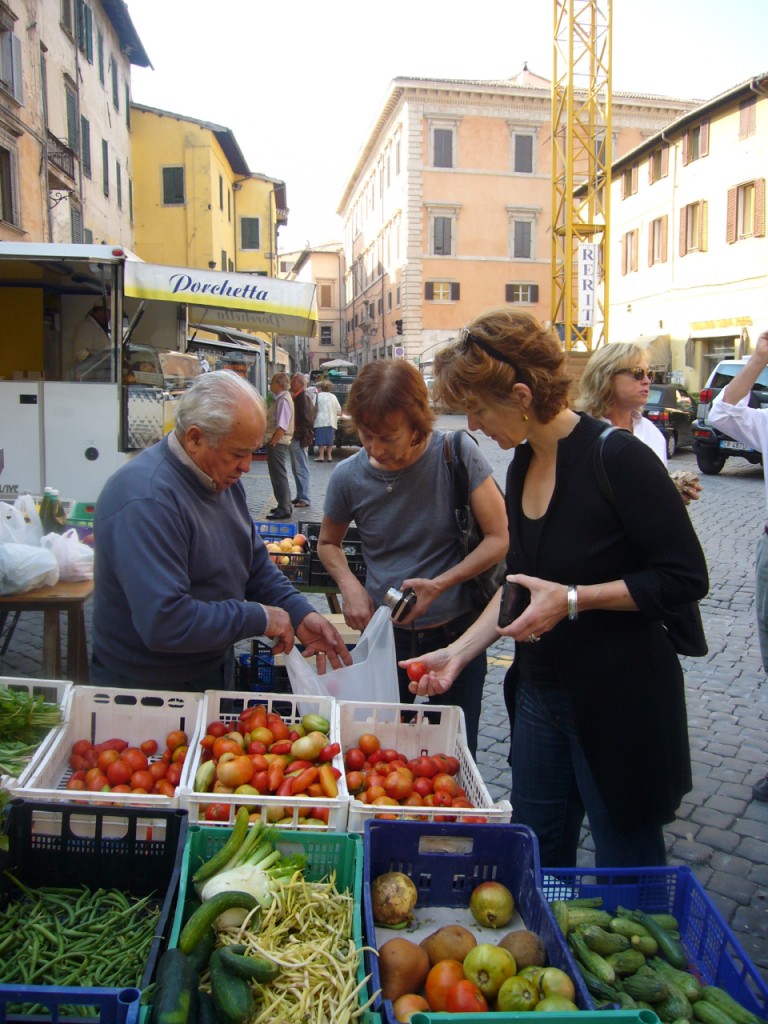 Refering to La Cucina: The Regional Cooking of Italy, by the Accademia Italiana della Cucina for a traditional porchetta recipe, I found the following description:
Refering to La Cucina: The Regional Cooking of Italy, by the Accademia Italiana della Cucina for a traditional porchetta recipe, I found the following description:
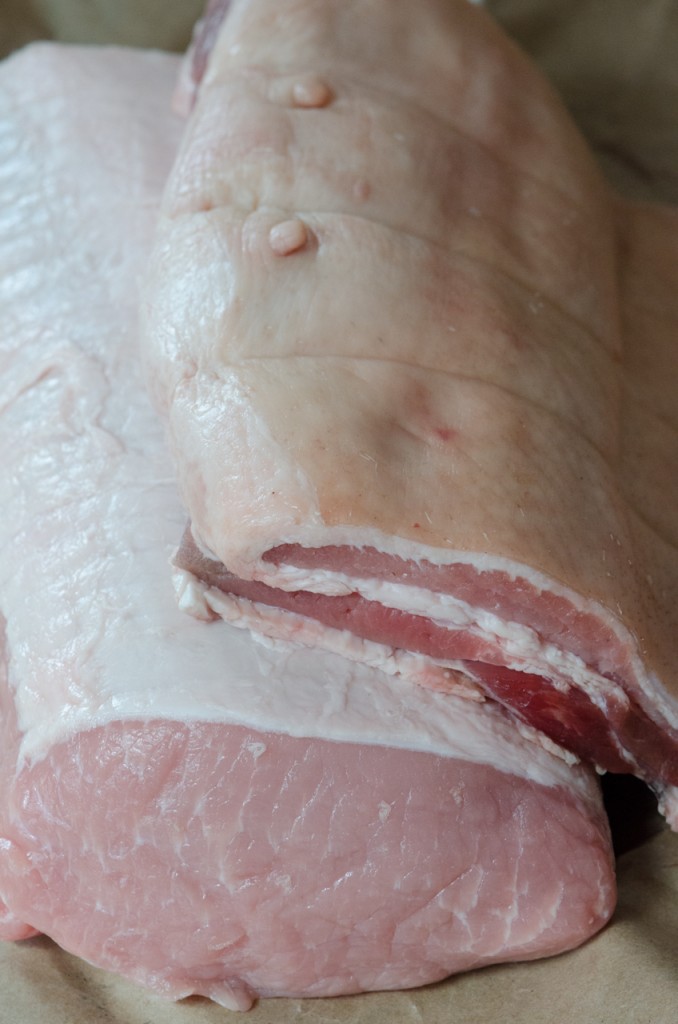 “To prepare this traditional Umbrian recipe for a whole spit-roasted, the animal, optimally weighing between 70 and 100 pounds, would first be carefully cleaned and all bristles scraped from the hide. The entrails would be removed and cleaned: the intestines and tripe defatted and placed under salt with a little vinegar, later rinsed and chopped, the heart, lungs, spleen and liver cleaned and chopped. The combined entrails would then be seasoned with salt and pepper and mixed with a generous amount of parboiled fennel and garlic to make a savory filling. Numerous deep cuts would be made into the skin of the pig and the filling both stuffed into the cavity and rubbed into the cuts. After sewing the pig closed and securing it with wire, it would be roasted in a very hot wood-burning oven on two metal sawhorses, usually for about 2 1/2 hours.”
“To prepare this traditional Umbrian recipe for a whole spit-roasted, the animal, optimally weighing between 70 and 100 pounds, would first be carefully cleaned and all bristles scraped from the hide. The entrails would be removed and cleaned: the intestines and tripe defatted and placed under salt with a little vinegar, later rinsed and chopped, the heart, lungs, spleen and liver cleaned and chopped. The combined entrails would then be seasoned with salt and pepper and mixed with a generous amount of parboiled fennel and garlic to make a savory filling. Numerous deep cuts would be made into the skin of the pig and the filling both stuffed into the cavity and rubbed into the cuts. After sewing the pig closed and securing it with wire, it would be roasted in a very hot wood-burning oven on two metal sawhorses, usually for about 2 1/2 hours.”
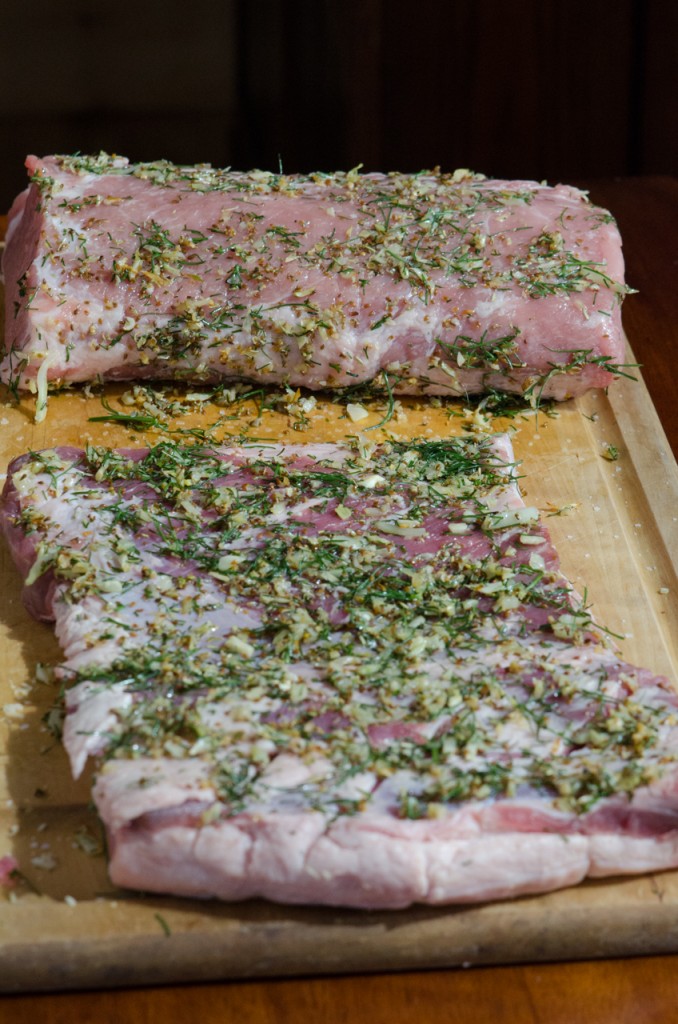 I am usually game for anything, and we have in fact roasted an entire pig, but the whole entrail thing is a bit daunting, and really not possible unless you are butchering the pig yourself. I wanted to create a recipe that would recreate the flavors and textures of porchetta in Italy – the simple but savory seasonings; the lean, moist center, still juicy, surrounded by a bit of fat and crispy skin – without buying (and then having to eat) an entire pig.
I am usually game for anything, and we have in fact roasted an entire pig, but the whole entrail thing is a bit daunting, and really not possible unless you are butchering the pig yourself. I wanted to create a recipe that would recreate the flavors and textures of porchetta in Italy – the simple but savory seasonings; the lean, moist center, still juicy, surrounded by a bit of fat and crispy skin – without buying (and then having to eat) an entire pig.
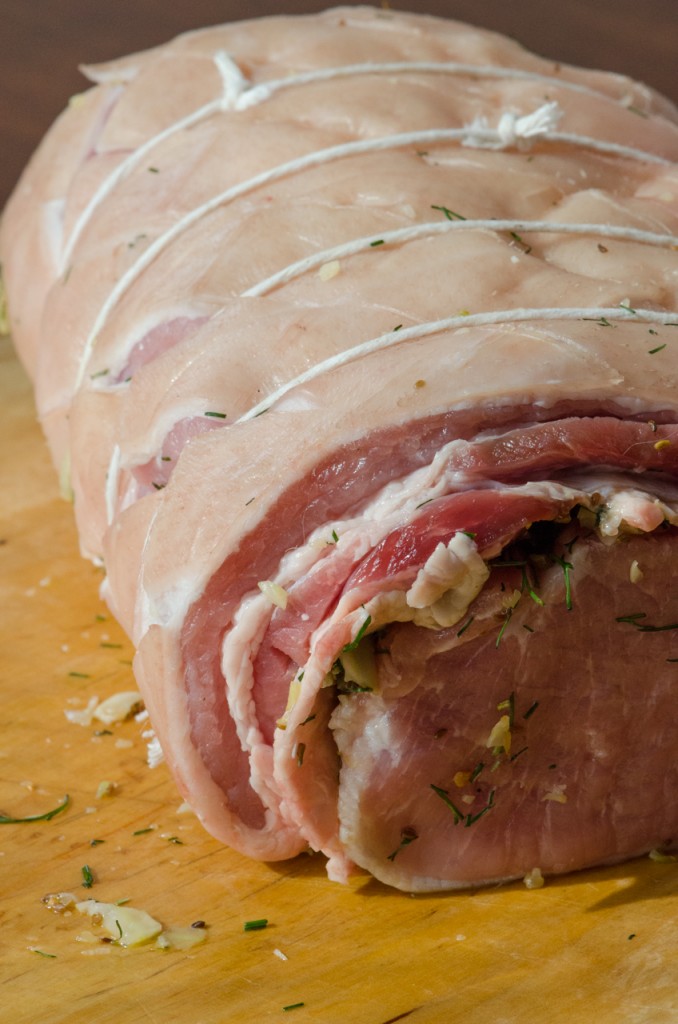 Purchasing a pork roast doesn’t do it, there’s no skin, and no fat. A pork belly has the latter two, but no lean meat. The simple solution – combine the two. Here, I season both a pork loin roast and a pork belly with garlic, fennel, rosemary and salt, then wrap the belly around the loin and roast it. We enjoyed thick slices of porchetta for dinner, then tasty porchetta sandwiches for lunch the following day. Not quite the same as enjoying them in the middle of an Umbrian market, but certainly a tasty Sunday night dinner.
Purchasing a pork roast doesn’t do it, there’s no skin, and no fat. A pork belly has the latter two, but no lean meat. The simple solution – combine the two. Here, I season both a pork loin roast and a pork belly with garlic, fennel, rosemary and salt, then wrap the belly around the loin and roast it. We enjoyed thick slices of porchetta for dinner, then tasty porchetta sandwiches for lunch the following day. Not quite the same as enjoying them in the middle of an Umbrian market, but certainly a tasty Sunday night dinner.
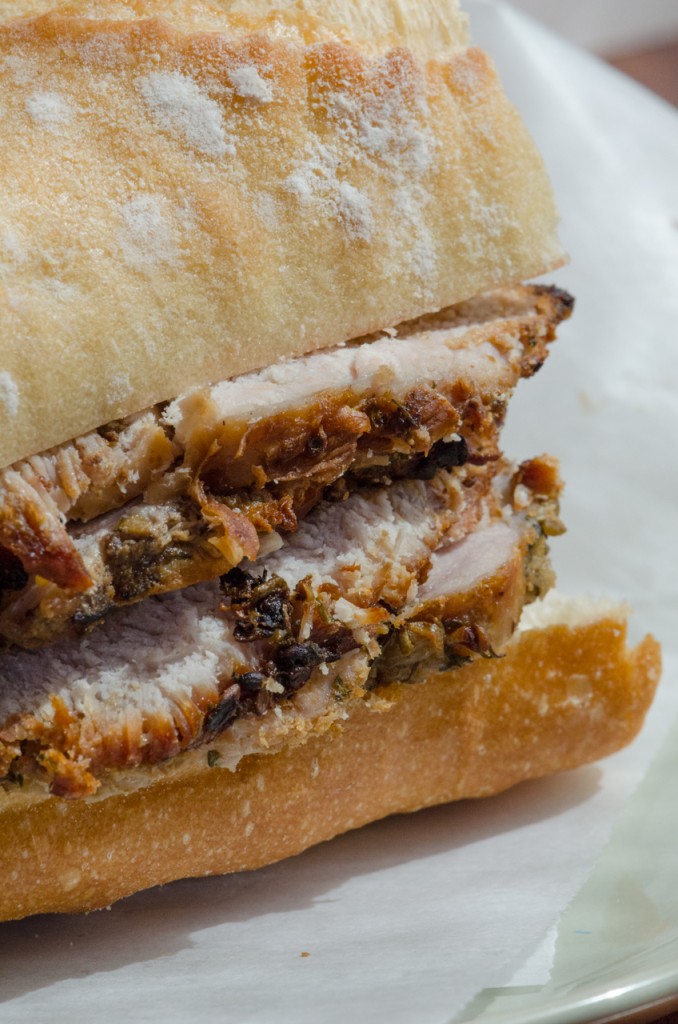 This is best started the day before you wish to serve it, but not absolutely necessary!
This is best started the day before you wish to serve it, but not absolutely necessary!
Porchetta
This is best started the day before you wish to serve it, but not absolutely necessary!
1 2 1/2 – 3 pound piece fresh pork belly, skin on
1 2 1/2 – 3 pound boneless pork loin
Kosher salt
2 tablespoons fennel seeds
2 tablespoons olive oil
1/2 bulb fresh fennel, tough outer layer and inner core removed, chopped into 1/4 inch dice
3 garlic cloves, minced
1 tablespoon minced fresh rosemary, or 1 teaspoon dried
1/4 cup fennel fronds, finely chopped
Preheat oven to 500°F.
Set belly skin side up. Using a sharp knife or box cutter, score the skin on each diagonal, making a diamond shaped pattern. Try to cut only the skin itself, but don’t worry too much if you cannot pierce the skin everywhere, or if sometimes you cut a little deeper. It is hard to penetrate the skin consistently, even with a very sharp knife.
Flip the belly so the skin side is down. Score the belly flesh in the same diagonal diamond shaped pattern.
Salt both sides of the belly, as well as the loin. Set aside while you make the seasoning mixture.
Place the fennel seeds in a hot sauté pan, and toast just until they are aromatic and starting to brown. Add the olive oil, chopped fresh fennel, garlic and rosemary, and saute until the fennel is soft, about 4 minutes. Add the chopped fennel fronds and remove from heat.
Cover the entire loin and the flesh side of the pork belly with the seasoning mixture. Roll the belly around the loin so the short ends of the belly meet, or come as close to meeting as possible. If there is a bit of loin still exposed along the bottom, don’t worry, we’ll put this at the bottom and no one will ever know. If the loin is longer than the pork belly, or the belly longer than the loin, and one sticks out, trim so the ends are flush.
Tie the roast with kitchen twine at about 1/2” intervals. Place the roast on a wire rack set in a sheet pan, with any gap where the pork belly may not cover the loin at the bottom. If you have the luxury of time, place the roast, uncovered, in your refrigerator for 1-2 days to allow the seasonings to penetrate the roast and the skin to air-dry. When ready to cook, removed the roast from the refrigerator and allow to sit at room temperature for 2 hours.
Preheat oven to 500°F.
Place roast in preheated oven, and roast for 45 minutes. Reduce heat to 300° and continue to roast until the porchetta reaches an internal temperature of 140°, about 1 1/2 to 2 hours more. If the skin is not as brown and crispy as you’d like, turn on the broiler and finish browning the skin, keeping a careful eye on it so it doesn’t burn.
Slice into 1/2 inch rounds for serving as a roast, or into very thin slices for your porchetta sandwich.
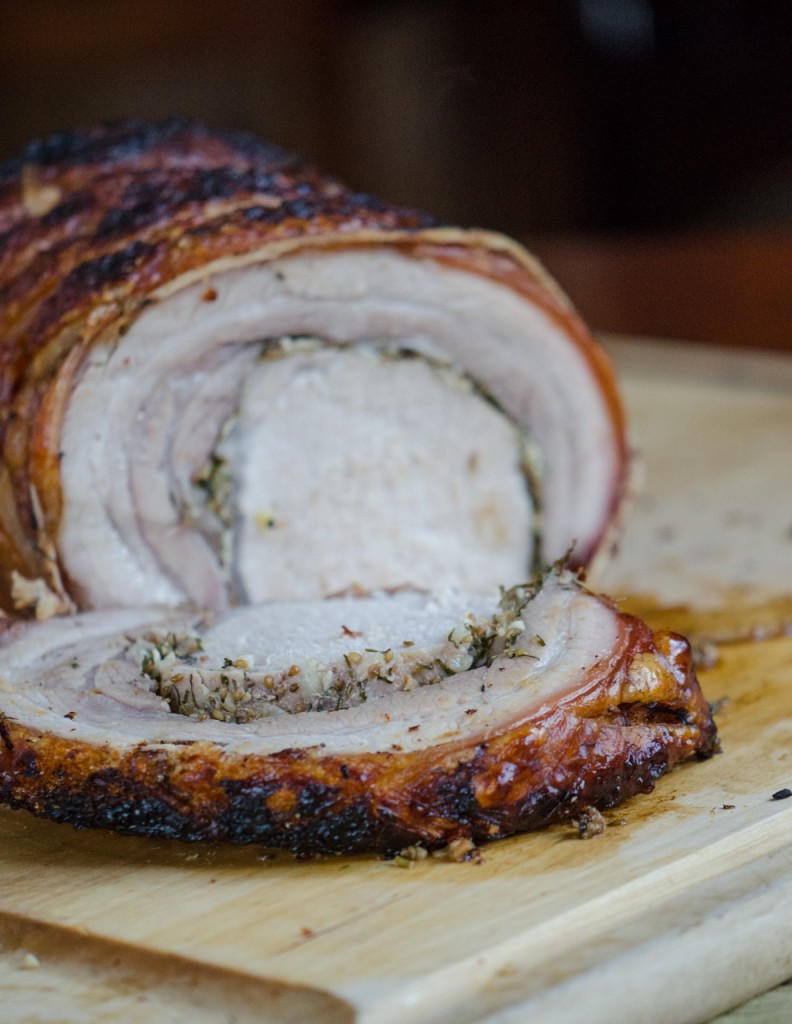
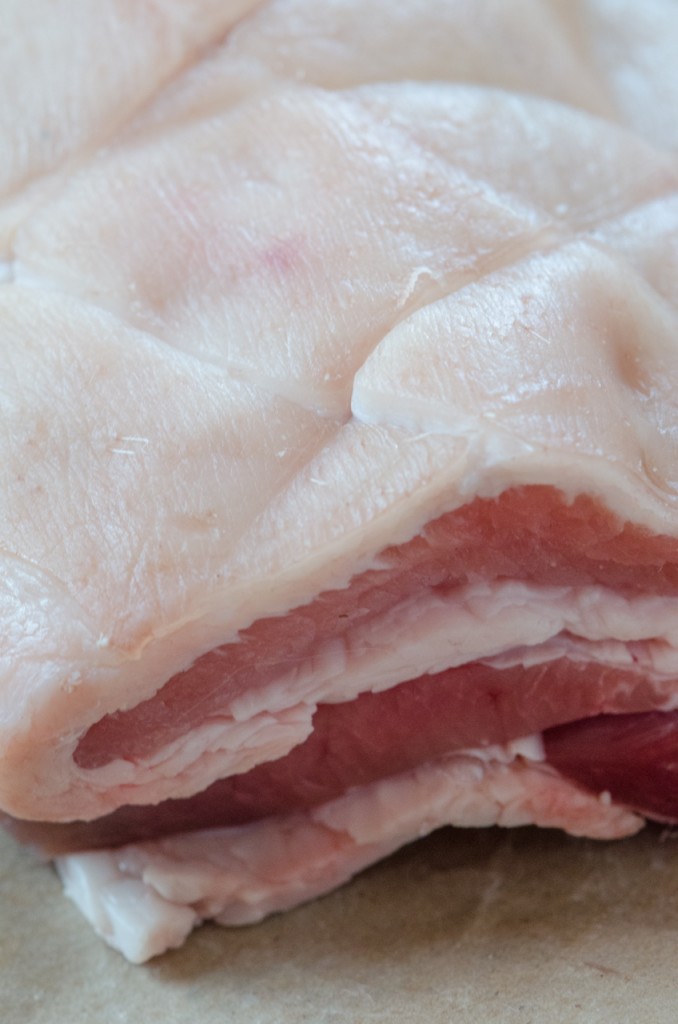
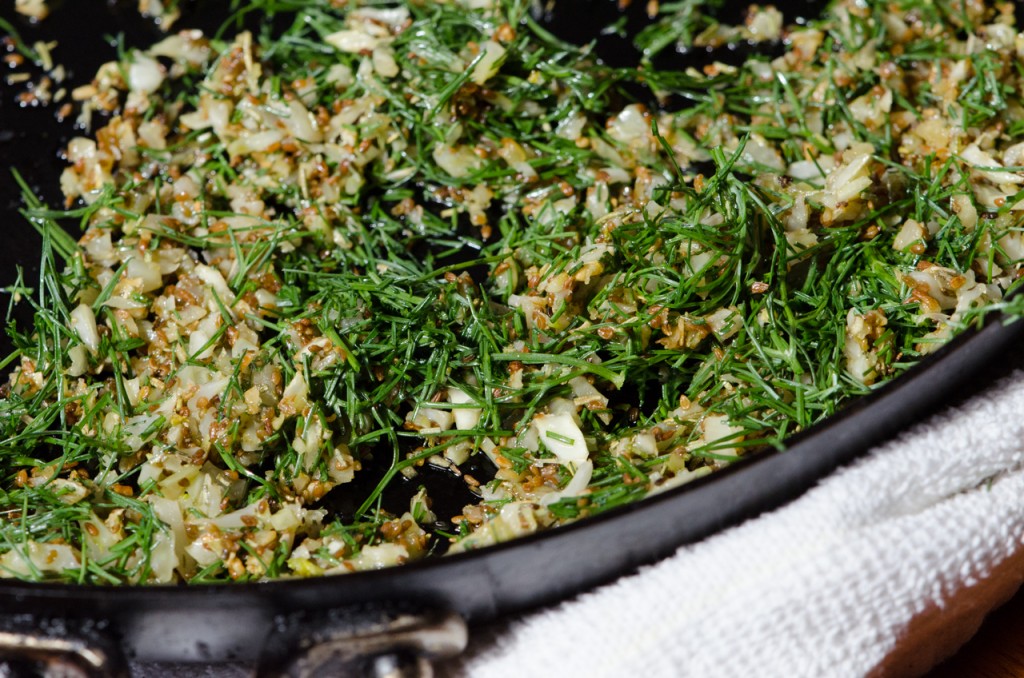

Pingback: Porchetta – Umbria’s Famed Roast Pork | goodthingsfromitaly